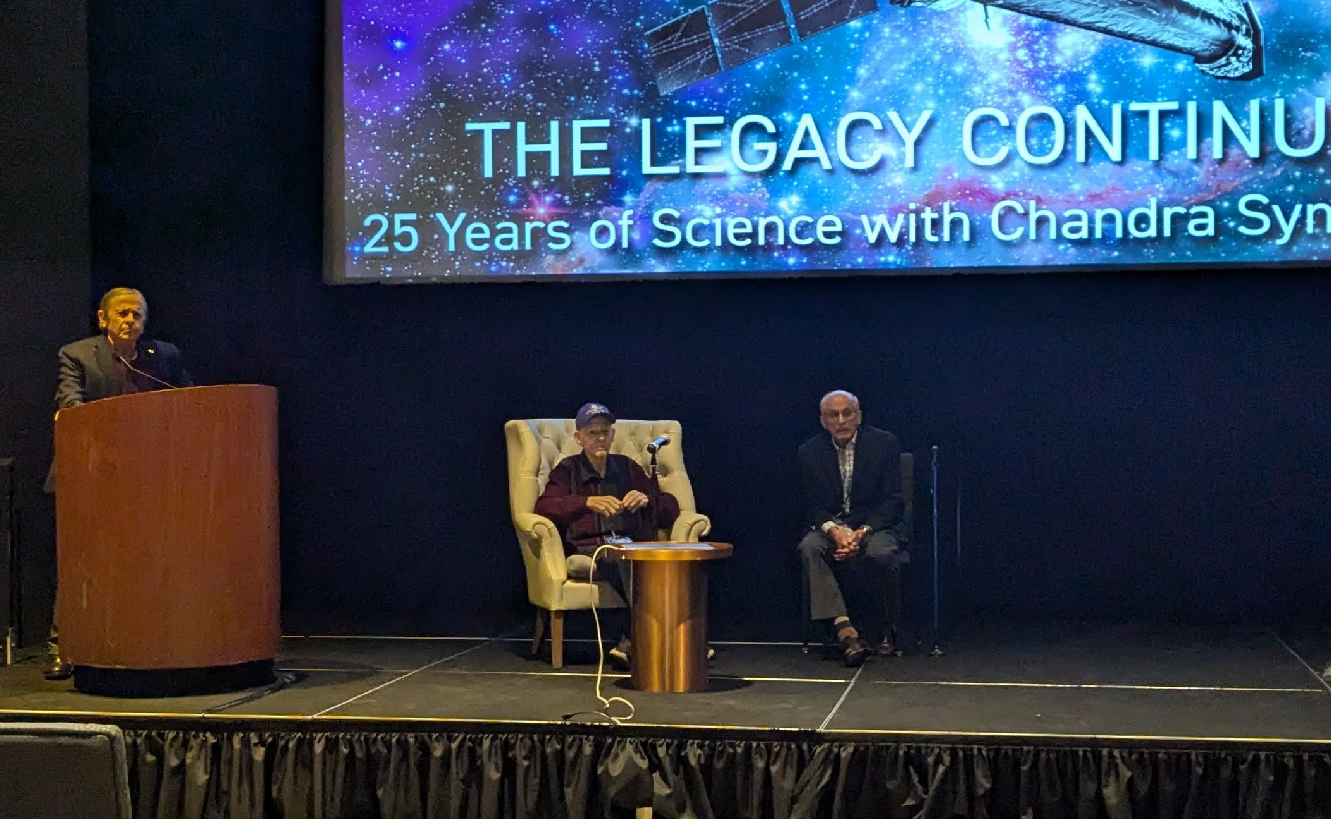Project Science Report
Douglas Swartz (USRA/MSFC); Steven Ehlert & Steve O'Dell (NASA/MSFC)
Last year was a celebration of Chandra's first twenty-five years of science, culminating in the symposium held last December in Boston. The greatest highlight for Martin Weisskopf, Chandra Project Scientist until his retirement in 2022, was the warmhearted standing ovation that he and Harvey Tananbaum received after presenting their retrospectives on the making of Chandra. Martin reports his great appreciation and that the experience was a "very touching" moment he remembers fondly.

Fig 1: Martin Weisskopf (center, seated) gave a retrospective of the development of Chandra at the Symposium in December, along with Harvey Tananbaum (right). Photo Credit: Thomas Connor
The last Newsletter described the Chandra Legacy Program and announced the selection of two proposals to carry out the Initiatives recommended for the Program. Observations to fulfill the proposed objectives began in mid-December 2024 with a 10 ks observation toward a "Deep and Wide Imaging of the Cool Core of the Perseus Cluster." This was the first of 102 observations planned to accumulate 3 Ms of data on this enigmatic cluster of galaxies. The following day a 14.5 ks observation of the spiral galaxy NGC 5042 occurred, the first of 107 observations of 37 nearby galaxies totaling 2.9 Ms "…Probing the Baryon & Energy Cycle and X-ray Binary Evolution in Galaxies at High Angular Resolution." Project Science is excited about the Legacy Program concept and is eagerly watching the accumulation of these rich datasets, which are immediately released to the public. It is clear that the science return will be immense—easily meeting the challenging science objectives that only the capabilities of Chandra can achieve.
The current 11-year solar cycle began in December of 2019, meaning that the Sun is currently near its maximum activity level, and this solar cycle has been consistently stronger than the previous. Minimizing the exposure of Chandra's sensitive science instruments to damaging radiation is an ongoing effort, and one where the available data characterizing the radiation environment has changed significantly over the years. The most recent change to Chandra's radiation monitoring efforts occurred after the Side-B HRC anomaly in February of 2022, resulting in the TXings algorithm, which monitors count rates on the ACIS detector, becoming the only source of on-board radiation monitoring and safing. We are thrilled to report that ACIS's TXings algorithm has successfully put the observatory into a radiation safe configuration without controller intervention five times since the last Issue of the Newsletter (July 2024). There were also two commanded radiation safings based upon the Advanced Composition Explorer (ACE) observed 115–195 keV (P3) solar wind proton rates.
In this year only 4% of the science observing time was lost to radiation shutdowns. Chandra has managed to keep radiation exposure well below its annual budget every year since the transition to TXings as the sole radiation monitor. We recognize the radiation working group and the ACIS team at MIT for their vigilance and innovation in keeping Chandra safe, despite complications from both the natural environment and spacecraft operations.
Chandra is participating in more synergistic activities due to both the XRISM Xtend Transient Search functionality and the start of operation of the Einstein Probe, which has the primary goal of discovering X-ray transients. These recently-deployed missions are reporting new X-ray sources and events at a rapid pace, often requiring Chandra's exquisite spatial resolution and sensitivity to localize events and to follow their declining X-ray intensity.
Finally, we appreciate the continuing support of the astrophysics community—especially the Chandra Users Committee—for the Chandra mission. We hope for many more years of outstanding Chandra science.